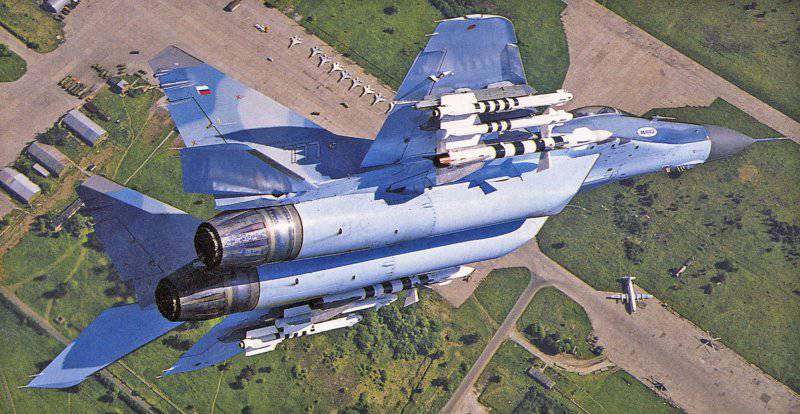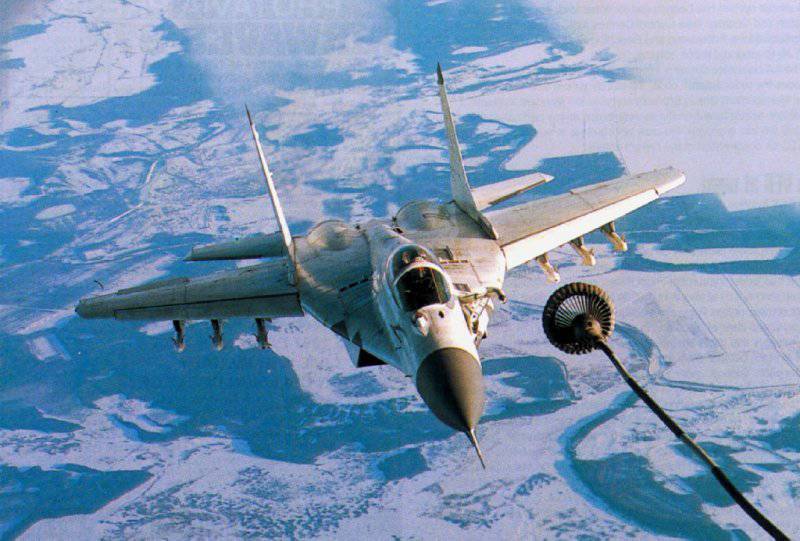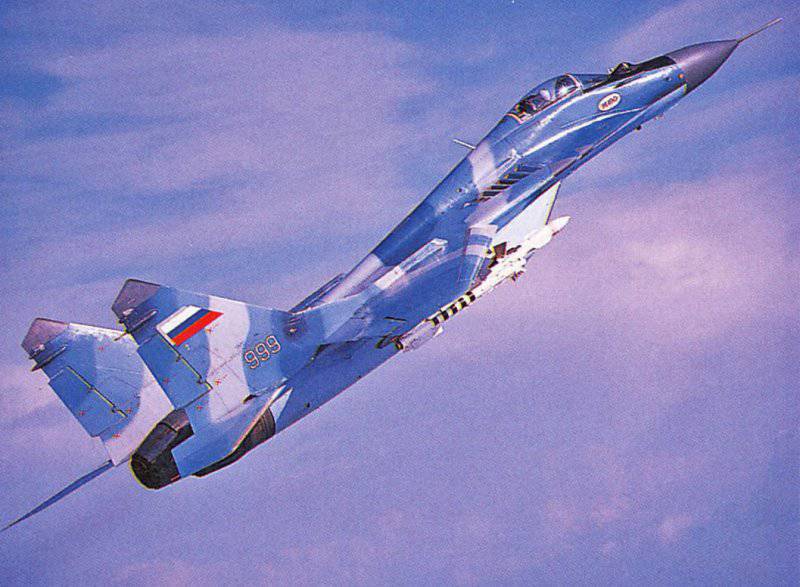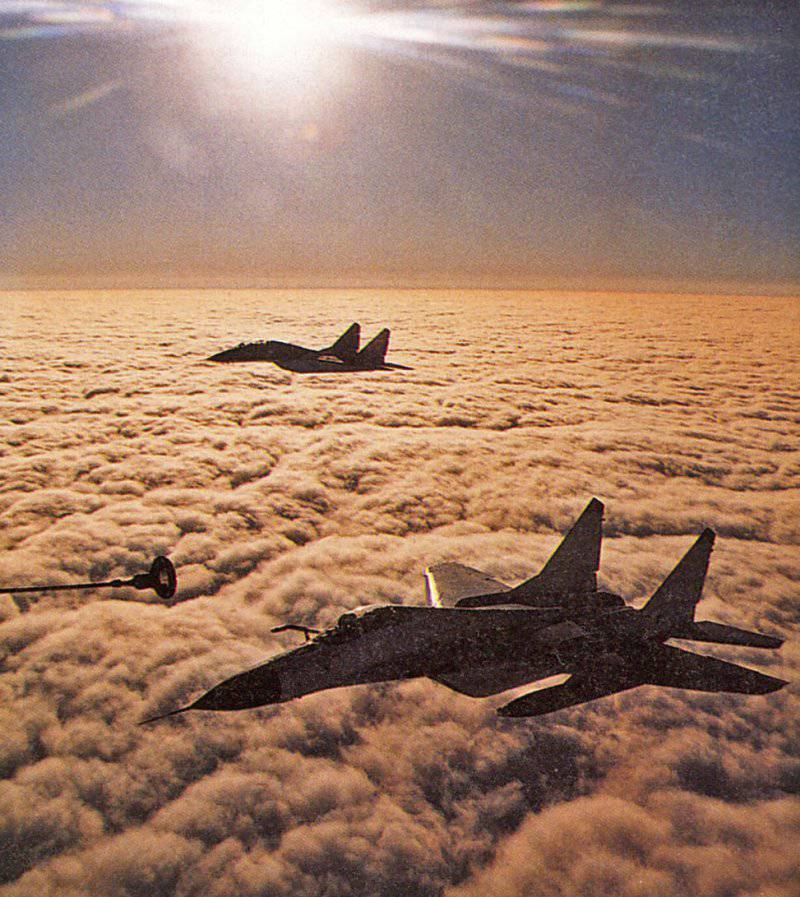Multipurpose MiG-29С fighter
Since the MiG-29М, recently released for testing, in the design and technology plan was quite different from the serial fighter, and the new weapon control system used on it required lengthy refinement, it was decided to unify the new version of the twenty-ninth with the 9- 13 ", mastered in production. The new fighter aircraft planned to introduce new air-to-air guided missiles, originally intended for the MiG-29M. This primarily concerned medium-range guided missiles RVV-AE with an active radar homing head, as well as a P-27T with a thermal homing head, the P-27Т and P-27РE increased launch range. The SUV-29S fighter armament control system was to be built on the basis of the RLPK-29М (radar sighting system) developed at NIIR (scientific and production association "Fazotron") under the guidance of Kirpicheva Yu.P. (and then V. Frantsev). The radar sighting complex consisted of the H019M radar, the new calculator Ts101M, and the optical-electronic sighting and navigation complex OEPrNK-29-1. From the previous RLPK-29, the advanced RLPK-29М was distinguished by increased noise immunity, a system of in-depth embedded monitoring, and new software. This upgrade allowed the simultaneous attack of 2 targets 2 missiles with TGS or ARGS. In OEPRNK-29-1 a combined control mode was implemented for firing at air targets from a cannon. Both complexes SUV-29С could also work in a training mode. The “MiGA” combat load was supposed to increase to 4000 kg (on four multi-lock wing wing holders a suspension of eight 500-kilogram bombs was provided), while the maximum take-off weight of the fighter reached almost 20 tons. In addition, the MiG-29С fighter was supposed to be equipped with a modified automatic control system, which provided improved stability characteristics and controllability at high angles of attack — the maximum angle was brought to 28 degrees.
The main task of the MiG-29C is the air defense of small territories, military groups and important objects. In this case, the tactic of using against air targets was assumed as follows:
Ground-based radar stations located in 10-15 kilometers from the line of combat contact (front line) guarantee radar control at a distance of almost 250 kilometers behind enemy aircraft at altitudes greater than 10 thousand. м. and 20-40 kilometers for low-flying targets. MiG-29 takes off from the airfield in standby mode, located from the front line ~ 100 km for a maximum of 8 minutes, it is guided to the target using a hidden transfer from the command point of dates automatically. Air targets flying at altitudes 20-23 th. м. at speeds up to 2 thousand km / h and at altitudes 10-20 th. м. at speeds up to 2,5 thousand km / h fighter can destroy even before they approach the front line. With an economical climb mode, the MiG-29 is capable of destroying stratospheric high-speed air targets at a distance of 240-230 km; and when flying with full afterburner mode - 170-180 km from the airfield. Fighter at medium altitudes suggest to the height of the target. To intercept air targets flying at altitudes 20-23 thousand. m, it suggests to a height of 16-17 th. м. If the MiG-29 should intercept the low-altitude aerial target, then it will fly to the 12-12,5 thou. м. In the future, the fighter moves to the height of 3,5-4 th. m, which ensures stable operation of the onboard RLPK, as well as the ability to perform the necessary vertical maneuver. MiG is induced in the forward hemisphere of the air target. If the first attack fails, the MiG manages to take up a position to carry out a second attack. Mikoyan to test weapons control systems re-equipped two serial MiG type «9-13». The first of them (No.405, onboard No.05) went up in air 20 on January 1989, the second - (No.404, onboard No.04) - 30 on June 1989. On these planes, the operation of the CCB-29C as a whole and the upgraded RLPK-29М, the use of RVV-AE missiles were tested. For example, on 405, for the first time, they carried out a successful simultaneous launch of 2-x missiles at 2-aerial targets. In the course of testing, it was proved that the new weapon control system provides for the sequential or simultaneous launch of rockets on targets that are spaced apart in azimuth over an angle of more than 8 degrees or located at a distance of more than 10 thousand. m on one azimuth. When entering the zone of allowed launches of both targets and the appearance of a single indication of the corresponding symbols on the system screen, the launch could be carried out in automatic or manual mode. If the targets in the zone of permitted launches entered one after another, successively, then rockets were launched in sequence, respectively. In September, the 1991 of the year ended up testing both machines. In 1994, the MiG-29С was adopted. By this time MAPO them. Dementieva produced almost 50 of such fighters, but only 16 of them were acquired by the air forces of Russia. The first MiG-29S entered the fighter regiment in Shaykovka, several vehicles of this type were also transferred to GLITZ in Akhtubinsk and the pulp and paper industry in Lipetsk. The equipment of the fighter with new medium-range missiles, mainly RVV-AE, with active radar homing heads, increased its effectiveness in air combat 2,5-3 times compared with the serial "twenty-ninth."
Nevertheless, in 1992, the Russian Ministry of Defense decided to stop the purchase of the MiG-29 - it was considered impractical in the conditions of the economic crisis to simultaneously build two types of front-line fighters. As noted, in the first half of the 1970s the basis of the concept of the fighter park aviation The country's air force was based on the principle of construction on the basis of two types: MiG-29 - 70% and Su-27 - 30%. It was also assumed that the ratio of the cost of these types of fighters will be 1: 1,9. But in practice, making the “instant” so cheap did not work: its cost was only 40-50 percent less than the “su” (in the world market, the cost of the Su-27 is estimated at 30-35 million dollars, and the MiG-29 - 22 -24 million dollars). Regarding the quantitative correlation of these types of aircraft in the structure of the Air Force, according to the data published in the press, it was slightly exceeded in favor of “twins”: in the European part of the USSR, by the end of 1990, at the time of signing the CFE Treaty, 648 MiG-29s and 138 Su were based -27 (82% and 18% respectively), not counting the fighter aircraft of the air defense and navy. After the collapse of the USSR, the Russian Air Force transferred about 400 MiG-29s (80 percent) and a little over 100 Su-27s (20 percent)
Thus, the 16 of the MiG-29C fighters launched at MAPO in the 1991 year have so far become the latest vehicles of this type that have entered service. Su-27 "lasted" a little longer, however, they were built only for the air defense forces. Further developments are known. At the beginning of 1997, at a press conference held at the Russian Ministry of Defense on financing the army, in particular, statistics were given on the procurement of new combat aircraft: the Russian Defense Ministry acquired 1994 machines in 7, 1995 in 1, and - not a single fighter. Moscow Aviation Production Association, specialized since the end of 1996-ies exclusively on the production of military equipment, with the 1960 year left without government order. The design bureau, by this time transformed into the Aviation Scientific-Industrial Complex "MIG", also received very scanty allocations. The only way out in the current situation could be the export of “MiGs”, especially since these planes were always popular in India, in the Middle East and in some former “fraternal” republics of Eastern Europe: by 1992, almost 1991 MiG-300 was sold in 29 foreign States.
Therefore, the 30 fighters of the MiG-29С that were not bought by the Russian Air Force were converted into an export version of the MiG-29СЭ. They are currently located in Lukhovitsy in the warehouse of the MAPS in storage. By the way, here are a few dozen of the new MiG-1992 of the type “29-9” released before 12 of the year. The design bureau prepared documentation for the refinement of such fighters in the MiG-29SD version, similar in weapon control system, the nomenclature used weapons and the MiG-29SE self-propelled gun (MiG-29CD differs from the MiG-29CE, it has a lower built-in REB equipment, therefore, it has a lower cost; the internal fuel supply on this aircraft is somewhat smaller, but the MiG-29СD fuel system provides suspension for the underwing suspended fuel tanks). It is the MiG-29SD that is the subject of negotiations on the well-known “Malaysian” agreement, which provides for the phased modernization of the delivered fighters, in particular, their equipment with an in-flight refueling system.
Both export vehicles are equipped with RLPK-29МE Topaz (radar sighting system) and OEPrNK-29-1E (optical-electronic sighting and navigation complex). The range of weapons of these fighters, in addition to the gun GSH-301 (150 ammunition ammunition), includes missiles near - up to 6 P-73; medium-range missiles - up to 6 RVB-AE, two P-27Т1 or P-27Р1; long-range missiles - two P-27РЭ1 or Р-27ТЭ1. In addition, the aircraft are armed with unguided rockets, bombs and incendiary tanks with a total weight of up to 4 tons, placed on 6 underwing points of the suspension. In accordance with the requirements of the customer, the composition of the aircraft equipment can be changed (it is also possible to use foreign equipment). For example, the fighters for the Malaysian Air Force set up the radio system TACAN AN / APN-118, instrumental landing equipment VOR / ILS-71, GPS receiver TNL-1000, the defendant of the state identification system COSSOR, the aircraft responder CO-69М, which Works in conjunction with Western navigation systems, an additional radio station P-800L1 of the decimeter and meter bands with a frequency of 243 MHz.
One of the conditions put forward by Malaysia when 07.06.1994 signed the contract for the supply of MiG-29 fighter jets was their equipment with in-flight refueling system. Prior to that, no serial MiG-29 had such a system (the refueling equipment was planned to be used only on the MiG-29K, therefore, in their design they immediately provided compartments for the placement of pipelines and a fuel receiver bar). It was impossible to install a retractable refueling bar in front of the cockpit on the MiG-29 (MiG-31B, MiG-29К, Su-30, Su-27К, Su-24М, etc.) without serious alterations to the structure. In this regard, the specialists of MAPO MIG developed a compromise solution, the system was made removable with the placement of part of the equipment (bar, bar mount and piping attachment points) in a fairing jutting out at the junction of the aircraft cockpit and left wing flow.
The weight of the sliding boom-fuel receiver was equal to 75 kilograms, and the rest of the system elements - up to 30 kilograms. The tip of the rod was unified for receiving fuel from the Il-78 tanker aircraft, and from foreign tankers KS-130, KS-10, etc. It is possible to refuel both the internal and outboard tanks of the fighter, the maximum fuel transfer rate is 900 liters per minute. The fuel receiver, the support beam, which supports it in the extended position, and other protruding parts of the system can be removed from the aircraft within an hour and, if necessary, installed again. The design of the refueling system makes it possible to install it on any modification of the MiG-29 with a minimum of aircraft modifications. To facilitate the refueling process, the fighter’s ACS and navigation equipment were also slightly modified. Search and guaranteed meeting with the tanker aircraft are provided by the onboard short-range navigation system. The pilot, after the release of the fuel-receiver bar, switches the automatic control system to the “stabilization during refueling” mode, and it, parrying external disturbances, keeps the vehicle at the required distance from the tanker.
In 1995, the new MiG-29 №4808, the onboard №357 were converted for testing of the new refueling system. 16 November 1995, the first refueling from tanker Il-78 was performed by R.P. Taskaev, chief pilot of MAPO "MIG". In the tests of the system also took part MR. Alykov, test pilot OKB, and also A.A. Goncharov and V.D. Shushunov, military pilots. According to the testers, the refueling system implemented on the MiG-29 makes this difficult stage of the flight accessible even to mid-skilled pilots, and the equipment that provides the search for the tanker and docking is much better than previously used on Russian-made military aircraft. Tests have shown that the installation of the fuel receiver in the external fairing did not have a significant impact on the flight characteristics, stability and controllability of the MiG-29. The ferrying range with three outboard fuel tanks increased from 2900 to 5200 kilometers with one refueling. Refueling was performed at altitudes up to 8 km at speeds of 400-600 km / h. A number of refueling stations were also made at speeds of 350-500 km / h to simulate fuel intake from the KS-130 (the Malaysian Air Force has 6 C-130 transport turboprop aircraft that can be converted into tankers). In January, 1996 completed flights under the test program and the refueling system was recommended for use on the MiG-29 of various modifications.
Aircraft performance characteristics:
Modification - MiG-29С;
Length - 17,32 m;
Height - 4,73 m;
Wingspan - 11,36 m;
Wing area - 38,06 m2;
Empty weight - 11200 kg;
Normal take-off weight - 15600 kg;
Maximum take-off weight - 19700 kg;
Internal fuel - 4540 kg;
Fuel in hanging tanks - kg 3800;
Engine type - 2 TRDDF RD-33;
Thrust - 2x8300 kgf;
Maximum speed at height - 2450 km / h;
Maximum speed at the ground - 1500 km / h;
Practical range at low altitude - 710 km;
Practical range at high altitude - 1500 km;
Practical range with outboard tanks - 2100 km;
Maximum rate of climb - 19800 m / min
Practical ceiling - 18000 m;
Crew - 1 man;
Armament:
- one built-in gun GSH-301 caliber 30 mm;
- combat load - 4000 kg
The six underwing nodes housed:
- from 2 to 4 URVV P-27P / 6 RVV-AE / to 6 P-60M or P-73
- 500- or 250-kg bombs, container KMGU;
- in blocks B-8М1 and С-24Б НАР 80 С-8.




Information